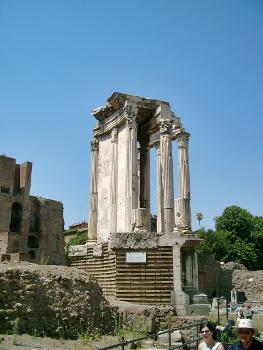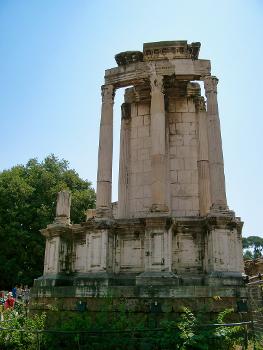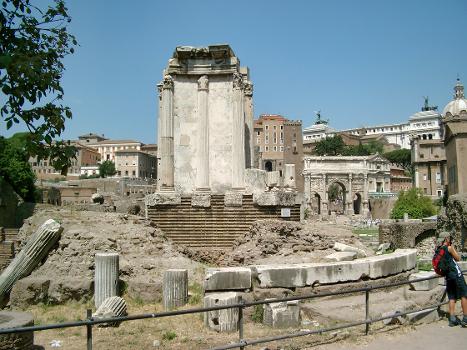General Information
| Name in local language: | Tempio di Vesta |
|---|---|
| Other name(s): | Aedes Vestae |
| Completion: | 4th century |
| Status: | in ruins |
Project Type
| Structure: |
Column and beam structure |
|---|---|
| Function / usage: |
Temple |
| Material: |
Masonry structure |
| Architectural style: |
Roman |
Location
Technical Information
There currently is no technical data available.
Excerpt from Wikipedia
The Temple of Vesta (Latin Aedes Vestae; Italian:Tempio di Vesta) is an ancient edifice in Rome, Italy, located in the Roman Forum near the Regia and the House of the Vestal Virgins. The temple's most recognizable feature is its circular footprint. Since the worship of Vesta began in private homes, the architecture seems to be a reminder of its history. The extant temple used Greek architecture with Corinthian columns, marble, and a central cella. The remaining structure indicates that there were twenty Corinthian columns built on a podium fifteen meters in diameter. The roof probably had a vent at the apex to allow smoke release.
The most prominent feature of the ruins that were once the Temple of Vesta is the hearth.
History
All temples to Vesta were round, and had entrances facing east to symbolize connection between Vesta’s fire and the sun as sources of life. The Temple of Vesta represents the site of ancient cult activity as far back as 7th century BCE. Numa Pompilius is believed to have built this temple along with the original Regia and House of the Vestal Virgins in its original form. Around the Temple stood The Sacred Grove, in which also there was a graveyard for the priests and virgins.
It was one of the earliest structures located in the Roman Forum although its present reincarnation is the result of subsequent rebuilding. Instead of a cult statue in the cella, there was a hearth which held the sacred flame. The temple was the storehouse for the legal wills and documents of Roman Senators and cult objects such as the Palladium. The Palladium was a statue of Athena (Roman Minerva) believed to have been brought by Aeneas from Troy; the statue was felt to be one of the Pignora Imperii, or pledges of imperium, of Ancient Rome. That the Romans believed that the Sacred fire of Vesta was closely tied to the fortunes of the city and viewed its extinction as a portent of disaster has been agreed on by all ancient accounts. The temple was closed during the persecution of pagans in the late Roman Empire in the 4th-century.
Reconstructions
The temple was rebuilt many times, for it was destroyed many times. The first destruction of the temple was by the Gauls in 390 BC. According to Ovid, the second time was in 241 BC; after fire destroyed much of Vesta's temple, Lucius Caecilius Metellus who was Pontifex Maximus at the time, saved the palladium and according to tradition was blinded in the incident. Such fires occurred again in 210 BC and again in the early first century BC; however, the building was safe. It was rebuilt again during the reigns of Augustus and Nero. Finally, it burnt down in 191 AD and was later built for the last time during the reign of Septimius Severus.
The Temple of Vesta remained reasonably intact until the Renaissance. However, in 1549 AD, the building was completely demolished and its marble reused in churches and papal palaces. The section standing today was reconstructed in the 1930s during the dictatorship of Benito Mussolini.
Text imported from Wikipedia article "Temple of Vesta" and modified on 23 July 2019 under the CC-BY-SA 3.0 license.
Participants
Currently there is no information available about persons or companies having participated in this project.
Relevant Web Sites
- About this
data sheet - Structure-ID
20009653 - Published on:
21/07/2003 - Last updated on:
28/05/2021









